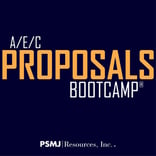 Most proposals consist of a cover letter, a collection of stock resumés, some project sheets with particulars of past projects, some extra boilerplate, and a list of names and phone numbers for references. They don’t “propose” anything of specific interest to the client.
Most proposals consist of a cover letter, a collection of stock resumés, some project sheets with particulars of past projects, some extra boilerplate, and a list of names and phone numbers for references. They don’t “propose” anything of specific interest to the client.
For every project, study the RFP, and determine the themes you should thread through your proposal. Here’s an orderly, five-step process to help you focus your thinking on the issues relevant to your client and the project.
1. Review what you know. You’ve already studied the RFP as part of your Go/No Go decision, searching for clues as to the client’s needs and desires. Look for:
• Scope of work statements.
• Performance standard statements.
• Written specifications.
• Client-implied requirements.
• Data requirements.
• Explicit proposal instructions.
• Evaluation criteria and weightings.
• Spoken and unspoken “rules of the game.”
• Page count limitations.
• Client-preferred solutions.
• Previous experience with this client.
• Previous winning proposals for his client.
2. Prepare a proposal outline. Convert each point in the RFP, the scope of work, the performance standard, instructions, and evaluation criteria into sections, headings, subsections, and paragraphs.
• Follow the order of the RFP.
• Address hidden or implicit instructions.
• Include a response to every RFP item.
• Use the same terminology as the RFP.
• Address the “what, why, and how” of your proposal solutions.
• Identify themes.
• Allocate pages according to relative importance of evaluation criteria.
3. Define “what” has to be addressed. Look in the RFP for stated requirements:
• Proposal instructions.
• Evaluation criteria including weighting factors.
• Scope of work requirements.
• Performance specifications.
• Page count limitations.
• Other requirements.

Read between the lines and do your own research for:
• Weaknesses in the concept.
• Weaknesses in your competitors. Without talking directly about competitors in your proposal, you can talk
about the strengths that make you a better choice.
• Unwritten requirements.
• Political considerations.
• Previous successful proposals for this client (if the
strong points relate to your strategy for this project).
4. Articulate “how” you will do it. Here’s where your proposal will become a game plan for this project, rather rather than a recounting of projects you’ve done before. Address the technical “how.” Satisfy all the technical requirements of the proposal.
• Show that you understand the technical tasks as the client sees them.
• Identify all the skills and disciplines required to do each task.
• Present sound, proven technical solutions to perform the work.
• Commit to your approach without wavering.
• Include informative, pertinent technical details (but don’t get carried away with jargon).
• Identify risks the client perceives and provide solutions and/or contingencies.
Address the management “how.” Show how you will control project logistics.
• Identify organizational and management responsibilities.
• Show how you’ll organize the project through a work breakdown structure.
• Show that your organization can mirror the client’s for seamless communications.
• Show your plan and control measures for keeping the project on track.
• Show that you’re prepared to deal with the unexpected.
5. Tell “why” you selected that approach. Tell why your method is best. For each “how,” give a “why.”
• Discuss choices you considered.
• Substantiate methods you know the client prefers.
• Show why you chose a subconsultant for a specific task.
• Identify previous experience where the method was successful.
• Tell about other situations where you learned lessons that lead you to propose this solution.
6. Build your proposal themes. Boil your strategic analysis down into a few themes that hit the hot buttons and recur throughout your proposal. Themes are the public face of your strategy. They’re your opportunity to turn features into benefits. They’re the reason a client will choose you. An extensive proposal for a complex project might include six or seven major themes, along with minor themes that support them. Themes come in three types:
• Response themes respond to the client’s stated and unstated needs and desires.
• Attack themes undermine your competition and show your contrasting strengths.
• Secret-weapon themes describe what makes you special.
When you work your themes into the proposal, remember: Themes don’t generally appear as headings of highlighted statements. Instead, they’re woven into the body of the proposal. The best places to insert them are as introductory sentences to subsections or paragraphs, and as bullet points in a summary. Also consider using themes in the executive summary and the transmittal letter.

This article is an expert from PSMJ's High Impact Proposals, a compilation of our most popular articles and thinking on what it takes to build a proposal that gets your architecture or engineering firm the job.
You also might be interested in these related blog posts:
Impress Clients with a Management Proposal
What’s So Special About Writing a Proposal?
Improving Your Hit Rate: Six Rules to Follow Now
26 Ways to Find Clients and Get Work
 Even with improving economic conditions, there are still more A/E firms chasing fewer opportunities. That seems to create intense downward pressure on fees, and you are left wondering how to actually grow your backlog and spend less time chasing dead-end project opportunities. You want more bang from your proposal investment buck. In our popular two-day A/E/C Proposals Bootcamp, you get information on what it takes to develop and implement winning proposal strategies.
Even with improving economic conditions, there are still more A/E firms chasing fewer opportunities. That seems to create intense downward pressure on fees, and you are left wondering how to actually grow your backlog and spend less time chasing dead-end project opportunities. You want more bang from your proposal investment buck. In our popular two-day A/E/C Proposals Bootcamp, you get information on what it takes to develop and implement winning proposal strategies.



